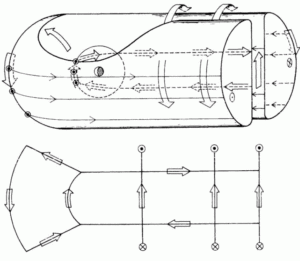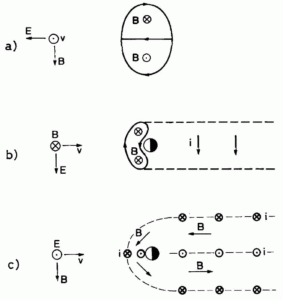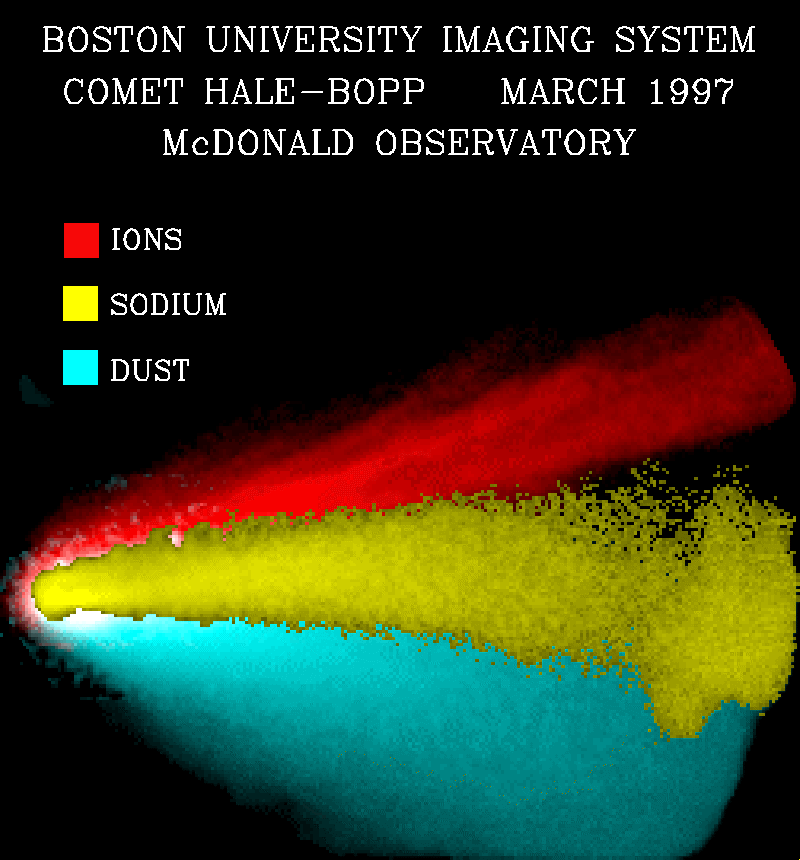A comet is a body in the solar system that orbits the Sun. It consists of a nucleus that is perhaps made of rock, dust, and ice, and may exhibits a coma (atmosphere, with associated ionosphere, magnetosphere, sometimes called a plasmasphere), and/or one or more tails: an ion tail (or plasma tail) and dust tail.
In the plasma of the solar wind, and due to the photoelectric effect, the comet nucleus may charge electrostatically, and the ions and dust in the ionosphere and tails produce their own magnetic and electric fields, and electric currents.
Contents
Interaction with interplanetary medium

- Electrostatic charging of the comet nucleus,[3] and, charging of the dust,[4] resulting in levitation of dust from the comet surface,[4]
- Coagulation of grains with opposite potentials,[5] and the opposite process, disruption (break-up) of grains with high potentials,[4]
- Plasma instabilities in the tail,[4]
- Folding of the interplanetary magnetic field into the tail of the comet (Alfvén’s “folding umbrella” hydromagnetic model, 1957)[6] [7]
- A cometary current system including plasma tail streamers separated by a neutral current sheet, with a total current exceeding 108A,[7]
- A shock-ionopause current system, a tail current system, and a field-aligned auroral current system,[2]
- The flow of such field-aligned currents leading to the generation of strong localized field-aligned electric fields (double layers),[2] [8]
- Acceleration of electrons to keV energies in such double layers would lead to the observed enhanced fluxes of suprathermal electrons.[2]
- Production of X-rays (e.g. such as those detected from Comet Hyakutake,[9][10][11] confirming the presence of Birkeland currents (field-align currents),[12]
- Jets, such as those produced and modelled by Kristian Birkeland’s theory,[13]
- The generation of magnetic fields and electric currents in cometary plasma tails, up to a billion Amps, [14] first proposed by Alfvén in 1957,[6] and “strikingly established during the crossing of the plasma tail of Comet Giacobini—Zinner by the ICE spacecraft on September 11, 1985 (Smith et al., 1986)”[15] [7]
- Currents in the cometary atmosphere,[16]
- Outbursts from the comet nucleus resulting form macroscopic electric double layers,[17]
- The origin of comet striae (banding) in dust tails,[18]
- Inner coma cometary plasma formation by the critical ionization velocity mechanism,[19] [20]
- Filamentary structure in comet tails interpreted as evidence of field-aligned currents (Birkeland currents),[7]
- A “cometary aurora” due to “current discharges into the atmosphere from the tail”[21]
- Possible ionization of the inner coma due to cross-tail currents closing through the cometary head.[22]
In 2004, NASA’s Stardust spacecraft on a mission to comet Wild 2 (pronounced “Vilt 2”), “found 20 jets, on both the sunlit side of the comet and, surprisingly, the dark side”.[23][24]
Comet tails
Fyodor Aleksandrovich Bredikhin (1831-1904) of Russia first “introduced a scheme for classifying cometary tails into three types, depending on whether the repulsive force was more than 100 times the gravity of the Sun (Type I) or less than one solar gravity (Types II and III)”[25], though the classification is rarely used now.
- Plasma tail, or ion tail, or ‘gas’ tail (formerly Type I tail): always points directly away from the Sun, and consisting of ions such as water ions, is often turbulent with twists and knots. It forms closer to the Sun that the dust tail, its origin is usually thought to be due to charge-exchange reactions and photoionization of atoms and molecules in the coma.
- Dust tail: (formerly Type II & III): Often a smooth curved tail, made of dust particles (the difference between the two types is due to the particle size distribution), and sometimes showing filamentary ‘striae’. The dust is usually thought to originate from the comet nucleus as gases vaporize
- Sodium tail: consisting of neutral sodium atoms
In 1957, two Belgian astronomers reported that Comet Arend-Roland had two tails pointing in opposite directions:
- “A comet can have more than one tail and the two tails point in opposite directions. In November 1956, two Belgian astronomers spotted Comet Arend-Ronald (sic). In April 1957, it appeared very strange. It appeared to have two tails pointing in opposite directions! This was very unusual. A comet’s tail normally points away from the Sun because of the solar pressure. This comet’s tail was pointing away from the Sun, but it was also pointing straight toward the Sun, too! Scientists later realized that the tail could only stay like that for so long, and then it would turn back to normal. Scientists think the comet had two tails because dust particles got in the way of the comet’s orbit.”[26][27][28]
Venus’ tail

In the late 1970s, NASA’s Pioneer Venus Orbiter discovered that Venus had a tail, after “detecting bursts of hot, energetic ions, or plasma” at about 70,000 kilometres from the planet, due to the interaction of the Solar Wind with Venus’ atmosphere. [29] In the 1990s, the tail was found to extend almost as far the Earth, which Jet Propulsion Laboratory team member Marcia Neugebauer described as “a lot of little stringy things” like those of some comets, which can have several ion tails”.[29] [30]
Electric fields, currents and circuits
The Pioneer Venus Orbiter also identified an induced electric field in the tail, and magnetic field reversals indicative of electric currents.[31] Russian Venera probe measurements have been interpreted as unipolar induction effects.[32] Hannes Alfvén has noted:
- “As Venus, like the comets, has no appreciable intrinsic magnetic field, the solar wind interaction with her is likely to be essentially the same. Gringauz (1980)[33] has analysed the in situ measurements made by a Venera mission to Venus and constructed a current system which is similar to the Mendis model, which hence to a certain extent has been confirmed by in situ measurements.
- “The Gringauz current system has [..] surface [..] there is a neutral sheet [..] current flows in this sheet and closes through semi-circular loops `upwards’ and ‘downwards’ from the plane of symmetry.”[34]
Lunar tail
In 1999, the Moon was found to have a neutral sodium tail.[35]
Meteoroids
It is noted that by Murad and Williams (2002):
- “For low speed particles, it is worth noting that meteoroids in space are electrically charged due to cosmic rays, solar UV, and other effects (solar wind and ions and electron impacts). The electric charge changes according to the environmental conditions. In interplanetary space, the dust grains are positively charged because of photoelectron emission. However, meteoroids in plasma (magnetosphere) can be negatively charged: for example, from studies by Horányi (1996, 2000), on dust streams near Jupiter and Saturn, grains in a cold plasma are negatively charged, while those in a hot plasma switch their charged to positive values”[36]
History
Notes
- ↑ J. Wilson, J. Baumgardner, M. Mendillo, “Comet Observations with the Boston University Imaging System“
- ↑ 2.0 2.1 2.2 2.3 Mendis, D. A., “A cometary aurora” FULL TEXT (1987) Earth, Moon, and Planets (ISSN 0167-9295), vol. 39, Sept. 1987, p. 17-20. PEER REVIEWED
- ↑ Mendis, D. A.; Hill, J. R.; Houpis, H. L. F.; Whipple, E. C, “On the electrostatic charging of the cometary nucleus” FULL TEXT (1981) Astrophysical Journal, Part 1, vol. 249, Oct. 15, 1981, p. 787-797. PEER REVIEWED
- ↑ 4.0 4.1 4.2 4.3 Mendis, D. A.; Rosenberg, M., “Cosmic Dusty Plasmas” FULL TEXT (1994) Annual Review of Astronomy and Astrophysics, Volume 32, 1994, pp. 419-463 PEER REVIEWED
- ↑ Meyer-Vernet, N., “Flip-flop of electric potential of dust grains in space” FULL TEXT (1982) Astronomy and Astrophysics, vol. 105, no. 1, Jan. 1982, p. 98-106 PEER REVIEWED
- ↑ 6.0 6.1 Alfven, H., “On the theory of comet tails” (1957) Tellus, 9, 92. PEER REVIEWED
- ↑ 7.0 7.1 7.2 7.3 Mendis, D. A., “On the hydromagnetic model of comets” FULL TEXT (1978) Moon and the Planets, vol. 18, May 1978, p. 361-369.PEER REVIEWED. See also a comment and reply
- ↑ Alfven, H., Cosmic plasma (1981) Astrophysics and Space Science Library. Volume 82), 1981. ACADEMIC BOOK
- ↑ “First X-Rays from a Comet Discovered“, ROSAT Guest Observer Facility, NASA Goddard Space Flight Center (1996)
- ↑ C. M. Lisse et al, “Discovery of X-ray and Extreme Ultraviolet Emission from Comet C/Hyakutake 1996 B2” (1996) Science, Volume 274, Issue 5285, pp. 205-209 PEER REVIEWED
- ↑ Dennerl, K.; Englhauser, J.; Trümper, J., “X-ray Emissions from Comets Detected in the Rontgen X-ray Satellite All-Sky Survey” (1997) Science VOL. 277, 12 September 1997. Full text FULL TEXT PDF
- ↑ Peratt, Anthony L., “Advances in Numerical Modeling of Astrophysical and Space Plasmas” FULL TEXT (1996) Astrophysics and Space Science, Volume 242, Issue 1-2, pp. 93-163 PEER REVIEWED
- ↑ The Norwegian Aurora Polaris Expedition 1902-1903 Part II, Chapter 5. Is It Possible To Explain Zodiacal Light, Comets’ Tails, And Saturn’s Ring By Means Of Corpuscular Rays? (1913) ACADEMIC BOOK Section 124. Comet Tails FULL TEXT
- ↑ Ip, W.-H.; Mendis, D. A., “The generation of magnetic fields and electric currents in cometary plasma tails (1976) Icarus, vol. 29, Sept. 1976, p. 147-151 PEER REVIEWED“
- ↑ Smith, E. J.; Tsurutani, B. T.; Slavin, J. A.; Jones, D. E.; Siscoe, G. L.; Mendis, D. A. “International Cometary Explorer encounter with Giacobini-Zinner – Magnetic field observations” (1986) Science (ISSN 0036-8075), vol. 232, April 18, 1986, p. 382-385. PEER REVIEWED
- ↑ Ip, W.-H., “Currents in the cometary atmosphere” (1979) Planetary and Space Science, vol. 27, Feb. 1979, p. 121-125. PEER REVIEWED
- ↑ Ibadov, Subhon, “Possible Mechanism of Cometary Outbursts” (2000) Minor Bodies in the Outer Solar System: Proceedings of the ESO Workshop Held at Garching, Germany, 2-5 November 1998, ESO ASTROPHYSICS SYMPOSIA. ISBN 3-540-41152-6. Edited by A. Fitzsimmons, D. Jewitt, and R.M. West. Springer-Verlag, 2000, p. 177
- ↑ Hill, J. R.; Mendis, D. A., “On the origin of striae in cometary dust tails” FULL TEXT (1980) Astrophysical Journal, Part 1, vol. 242, Nov. 15, 1980, p. 395-401 PEER REVIEWED
- ↑ Formisano, V.; Galeev, A. A.; Sagdeev, R. Z., “The role of the critical ionization velocity phenomena in the production of inner coma cometary plasma” (1982) Planetary and Space Science, vol. 30, May 1982, p. 491-497.
- ↑ Chang, T.-F.; Rahman, H. U.; White, R. S., “Laboratory simulation of cometary neutral gas ionization” (1989) Journal of Geophysical Research (ISSN 0148-0227), vol. 94, May 1, 1989, p. 5533-5538. PEER REVIEWED
- ↑ Houpis, H. L. F.; Mendis, D. A., “On the development and global oscillations of cometary ionospheres” FULL TEXT (1981) Astrophysical Journal, Part 1, vol. 243, Feb. 1, 1981, p. 1088-1102. PEER REVIEWED
- ↑ Mendis, D. A. & Ip, W.-H., “The ionospheres and plasma tails of comets” FULL TEXT (1977) Space Science Reviews, vol. 20, Mar. 1977, p. 145-190. (p.184) {{peer}
- ↑ space.com “Strange Comet Unlike Anything Known“, Robert Roy Britt, Senior Science Writer, 17 June 2004
- ↑ Zdenek Sekanina, et al, “Modeling the Nucleus and Jets of Comet 81P/Wild 2 Based on the Stardust Encounter Data” (2004) Science 18 June 2004, Vol. 304. no. 5678, pp. 1769 – 1774 PEER REVIEWED
- ↑ “comet“, Encyclopædia Britannica. 2007. Encyclopædia Britannica Online. 21 Nov. 2007
- ↑ ThinkQuest library, “Comets“
- ↑ BBC “Sky at Night”, 50th Anniversary Programme (2007)
- ↑ Opik, E. J., “Spike of Comet Arend-Roland 1956h, FULL TEXT (1958) Irish Astronomical Journal, vol. 5(2/3), p. 37 PEER REVIEWED
- ↑ 29.0 29.1 “Planet’s tail of the unexpected“,FULL TEXT New Scientist 31 May 1997
- ↑ Grünwaldt, H.; Neugebauer, M. et al, “Venus tail ray observation near Earth” (1997) Geophys. Res. Lett., Vol. 24, No. 10, p. 1163 – 1166 PEER REVIEWED
- ↑ Intriligator, D. S.; Scarf, F. L., “Wave-particle interactions in the Venus wake and tail” (1984), Journal of Geophysical Research (ISSN 0148-0227), vol. 89, Jan. 1, 1984, p. 47-55 PEER REVIEWED
- ↑ Eroshenko, E. G., “Unipolar induction effects in the magnetic tail of Venus” (Kosmicheskie Issledovaniia, vol. 17, Jan.-Feb. 1979, p. 93-105.) Cosmic Research, vol. 17, no. 1, July 1979, p. 77-87. PEER REVIEWED
- ↑ Gringauz, K. I., “A comparison of the magnetospheres of Mars, Venus and the earth” (1981) COSPAR, IUGG, and IAU, Symposium on Physics of Planetary Magnetospheres, 3rd, Budapest, Hungary, June 2-14, 1980.) Advances in Space Research, vol. 1, no. 1, 1981, p. 5-24 PEER REVIEWED
- ↑ Alfven, H., Cosmic plasma (1981) Astrophysics and Space Science Library. Volume 82), 1981. “III.5.3. “Current Systems in the Magnetosphere of Venus” Page 62 ACADEMIC BOOK
- ↑ Smith, S. M.; Wilson, J. K.; Baumgardner, J.; Mendillo, M., “Discovery of the distant lunar sodium tail and its enhancement following the Leonid meteor shower of 1998” (1999) Geophysical Research Letters, Volume 26, Issue 12, p. 1649-1652
- ↑ Edmond Murad, Iwan P. Williams, “Meteors in the Earth’s Atmosphere: Meteoroids and Cosmic Dust and their Interactions with the Earth’s Upper Atmosphere” (2002) Cambridge University Press, ISBN 0521804310 (p.257)
